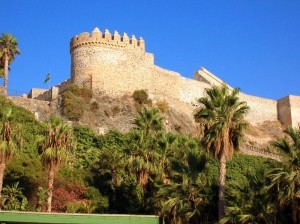Almuñecar, (Granada), Andalucia, (Spain)
 Almuñecar, together with its neighbour La Herradura form the tourist capital of the Costa Tropical in the province of Granada.
Almuñecar, together with its neighbour La Herradura form the tourist capital of the Costa Tropical in the province of Granada.
The town sits upon a hill at the mouth of two rivers, meandering down to the coast, in the province of Granada in Andalusia. Almuñecar lies on the coast 40 minutes drive from Granada and 90 kms. from Málaga. The city is flanked by the Sierra Nevada Mountains, with its international skiing resort open 6 months during winter, less than an hour’s drive away. Their height protects the area from the worst of the European winter weather, and the town has a population of about 25,000. The economy of the area used to be based on agriculture and fishing but today tourism has taken over. Water sports of all types are available and diving is particularly popular due to the wonderful underwater scenery.
The Town
The town has medieval steep winding streets that lead to the Plaza de Constitución, where the Town Hall stands, and onto the highest old quarter called Barrio San Miguel and onto the Moorish castle. Most of this area is pedestrianised and residential. Geranium-filled balconies and small sunny plazas line the labyrinth of narrow passageways; the town’s archaeological museum is located here. To the other side of the Plaza de la Constitución, next the Town Hall, a short rise leads up to the The Iglesia Mayor de la Encarnación (the main church) is located on the other side of the Plaza de Constitución, leading away from the town hall. The Casa de Cultura (cultural centre and auditorium) is also located in this district.
The Carretera de la Concepción, once formed a part of the main coast road and is now an attractive, but busy avenue. Here there is a fountain, where the old valley road heads towards Granada and, not far along the road are the excavated remains of part of an aqueduct and important Roman baths.
Beaches
Almuñecar has 19 kilometres of local coastline, which is diverse with 25 beaches along the coast of Almuñecar and La Herradura. Secluded coves, long sandy beaches and the town’s main beachfront with all its amenities and facilities. There are numerous options for water sports, including diving, the area is said to have some of the best underwater scenery anywhere along the southern coast.
The beachfront is divided in two by a large rocky outcrop known as the Peñon del Santo. The best beach, Playa de San Cristobal, stretches westwards from this rock, while the Playa Puerta del Mar is located to the east. Close to the Peñon del Santo is the Lori Sexi Ornothological Park which is home to over 1,000 birds. The many species include peacocks, doves, parrots, ostriches and water birds. The Aquatropic water park can be found next to Velilla beach. The are many water-flumes and rides including Kamikaze, the ring-rapids, with many sizes of pools, wave machine and waterfall. There are sun terraces, snack bars and a restaurant.
Places to visit
Almuñecar has its fair share of cultural and historic attractions, the first and most obvious being the Moorish castle, which was originally built on Roman foundations, however, what still stands is mainly from the Arab and Christian occupations.
The archaeological museum, which is located close to the castle; the building was formerly a Roman building, it is known as the Cave of the Seven Palaces, and holds some treasures, including a 3500 Egyptian vase.
The Majuelo Park is a lovely botanical garden, which sits in the shade of the castle. There is a vast array of exotic flora and the centrepiece of the park is the Roman ruins of old fish-salting pits. In summer, many open air concerts are performed beneath the castle including the annual Almuñecar Jazz Festival. The town has paid homage to local characters and resources with dedicated statues and monuments; there are monuments to sailors, fisherman, water, fertility, amongst others.
The area is also dotted with old watchtowers, as the area was infested with pirates. These look outs were built so that they could warn the local villages of certain invasion.
Further afield you can visit the interior of the region, to the Tropical Valley full of rich avocado orchards, which line the Rio Verde (Green River), visiting small inland villages and learning a little of the culture of the area. Follow the Rio Seco (Dry River) and you will reach the beautiful Peña Escrita Park, where you can go hiking, rambling, horse-riding or just taking in fresh air and magnificent scenery. The park also has log cabins where you can stay overnight and enjoy the typical spanish cooking at the only restaurant, lying on top of the mountain.
Salobreña is another coastal Moorish town, just east of Almuñecar. A picturesque white-washed village, definitely worth a visit.
Eating out
Almuñecar has a great selection of good quality restaurants, with a mix of traditional and international cuisines.
Climate
The Costa Tropical takes its name from the sub-tropical climate that it enjoys. With warm winters and long hot summers, the average temperature is around 20C.
Tourism Office
Palacete de la Najarra. Avda. de Europa, s/n, Almuñecar 18690 (Granada). Tel: (+34) 958 631 125. Email: turismo@almunecar.info
Video
Video and tourist information about Almunecãr